Competitive Strategy: Tools, Analysis, and Applications
VerifiedAdded on 2022/09/18
|10
|2251
|36
Report
AI Summary
This report provides a comprehensive analysis of competitive strategies, focusing on three key tools: Porter's Five Forces, PESTEL analysis, and SWOT analysis. The introduction defines competitive strategy as a long-term plan to gain a competitive advantage and generate a superior Return on Investment (ROI). The report then delves into Porter's Five Forces, examining competitive rivalry, supplier power, buyer power, the threat of substitution, and the threat of new entry, illustrating how these factors influence industry attractiveness and profitability. Next, the PESTEL analysis is explored, outlining the impact of political, economic, social, technological, environmental, and legal factors on organizations. Finally, the SWOT analysis is presented, detailing how to identify and leverage strengths, address weaknesses, capitalize on opportunities, and mitigate threats. The report concludes by emphasizing the importance of strategic planning and the use of these tools to navigate a competitive business environment.

Running head: COMPETITIVE STRATEGY
Key Strategy Development Tool
Name of the Student
Name of the University
Author note
Key Strategy Development Tool
Name of the Student
Name of the University
Author note
Paraphrase This Document
Need a fresh take? Get an instant paraphrase of this document with our AI Paraphraser
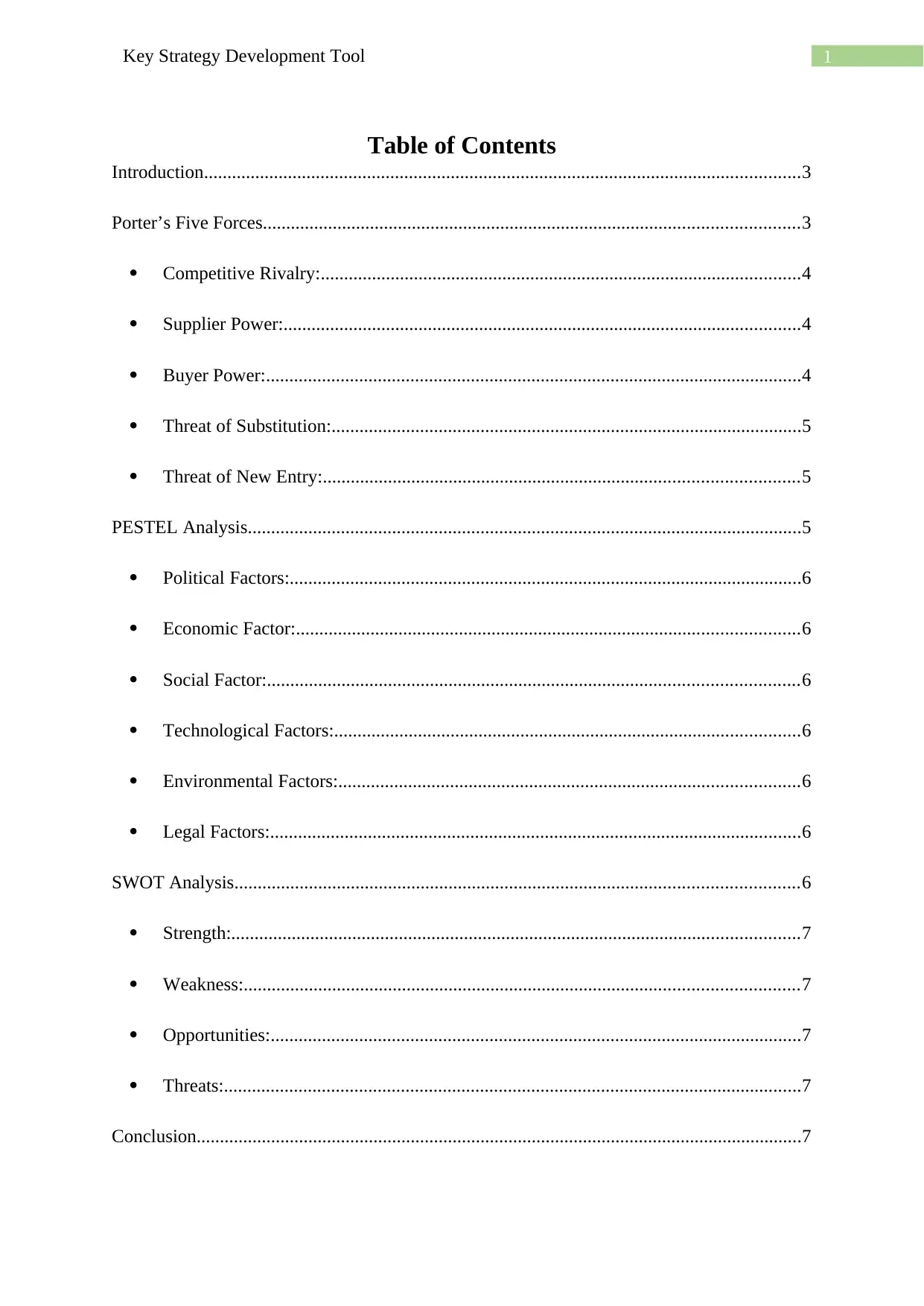
1Key Strategy Development Tool
Table of Contents
Introduction................................................................................................................................3
Porter’s Five Forces...................................................................................................................3
Competitive Rivalry:.......................................................................................................4
Supplier Power:...............................................................................................................4
Buyer Power:...................................................................................................................4
Threat of Substitution:.....................................................................................................5
Threat of New Entry:......................................................................................................5
PESTEL Analysis.......................................................................................................................5
Political Factors:..............................................................................................................6
Economic Factor:............................................................................................................6
Social Factor:..................................................................................................................6
Technological Factors:....................................................................................................6
Environmental Factors:...................................................................................................6
Legal Factors:..................................................................................................................6
SWOT Analysis.........................................................................................................................6
Strength:..........................................................................................................................7
Weakness:.......................................................................................................................7
Opportunities:..................................................................................................................7
Threats:............................................................................................................................7
Conclusion..................................................................................................................................7
Table of Contents
Introduction................................................................................................................................3
Porter’s Five Forces...................................................................................................................3
Competitive Rivalry:.......................................................................................................4
Supplier Power:...............................................................................................................4
Buyer Power:...................................................................................................................4
Threat of Substitution:.....................................................................................................5
Threat of New Entry:......................................................................................................5
PESTEL Analysis.......................................................................................................................5
Political Factors:..............................................................................................................6
Economic Factor:............................................................................................................6
Social Factor:..................................................................................................................6
Technological Factors:....................................................................................................6
Environmental Factors:...................................................................................................6
Legal Factors:..................................................................................................................6
SWOT Analysis.........................................................................................................................6
Strength:..........................................................................................................................7
Weakness:.......................................................................................................................7
Opportunities:..................................................................................................................7
Threats:............................................................................................................................7
Conclusion..................................................................................................................................7
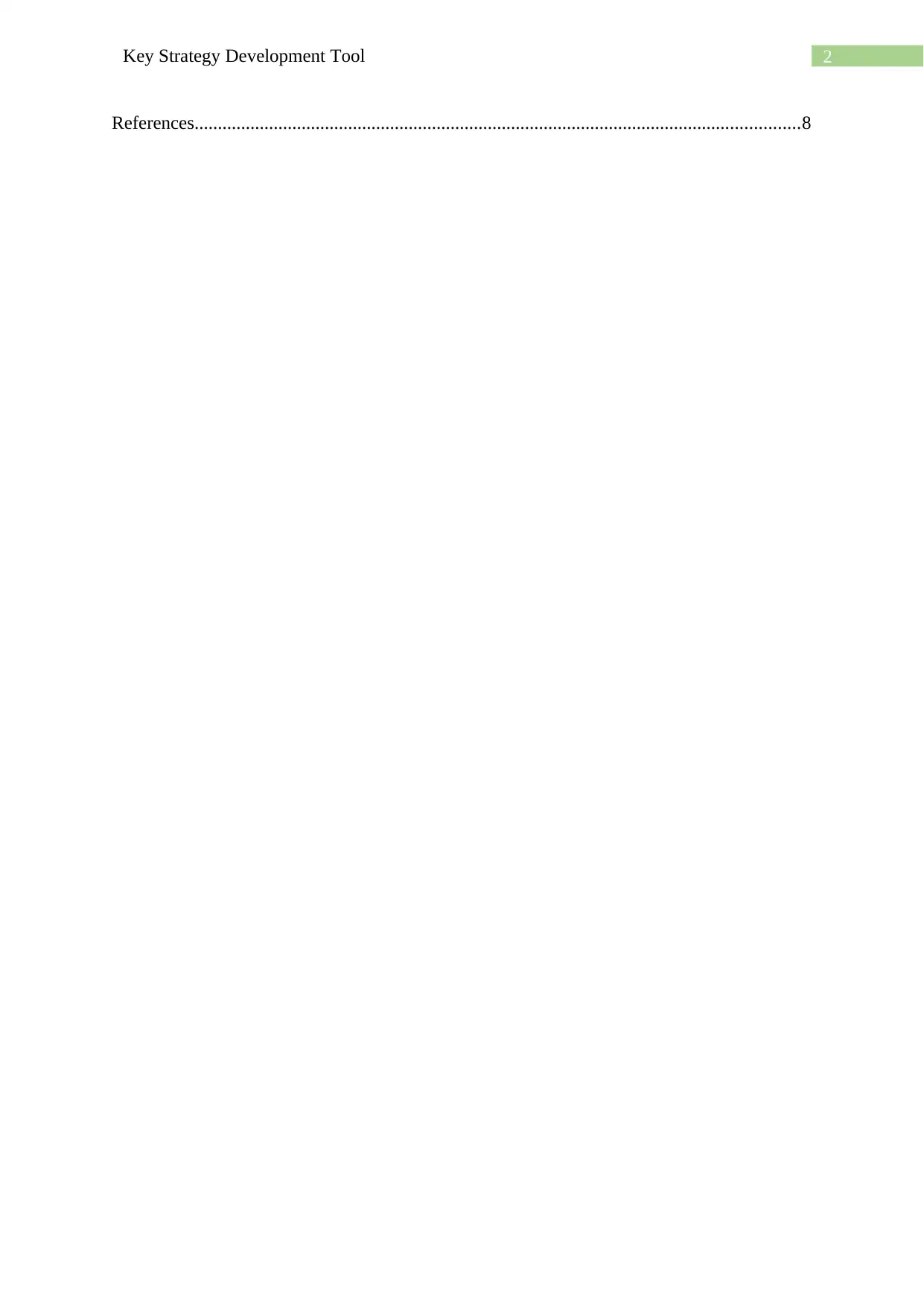
2Key Strategy Development Tool
References..................................................................................................................................8
References..................................................................................................................................8
⊘ This is a preview!⊘
Do you want full access?
Subscribe today to unlock all pages.

Trusted by 1+ million students worldwide
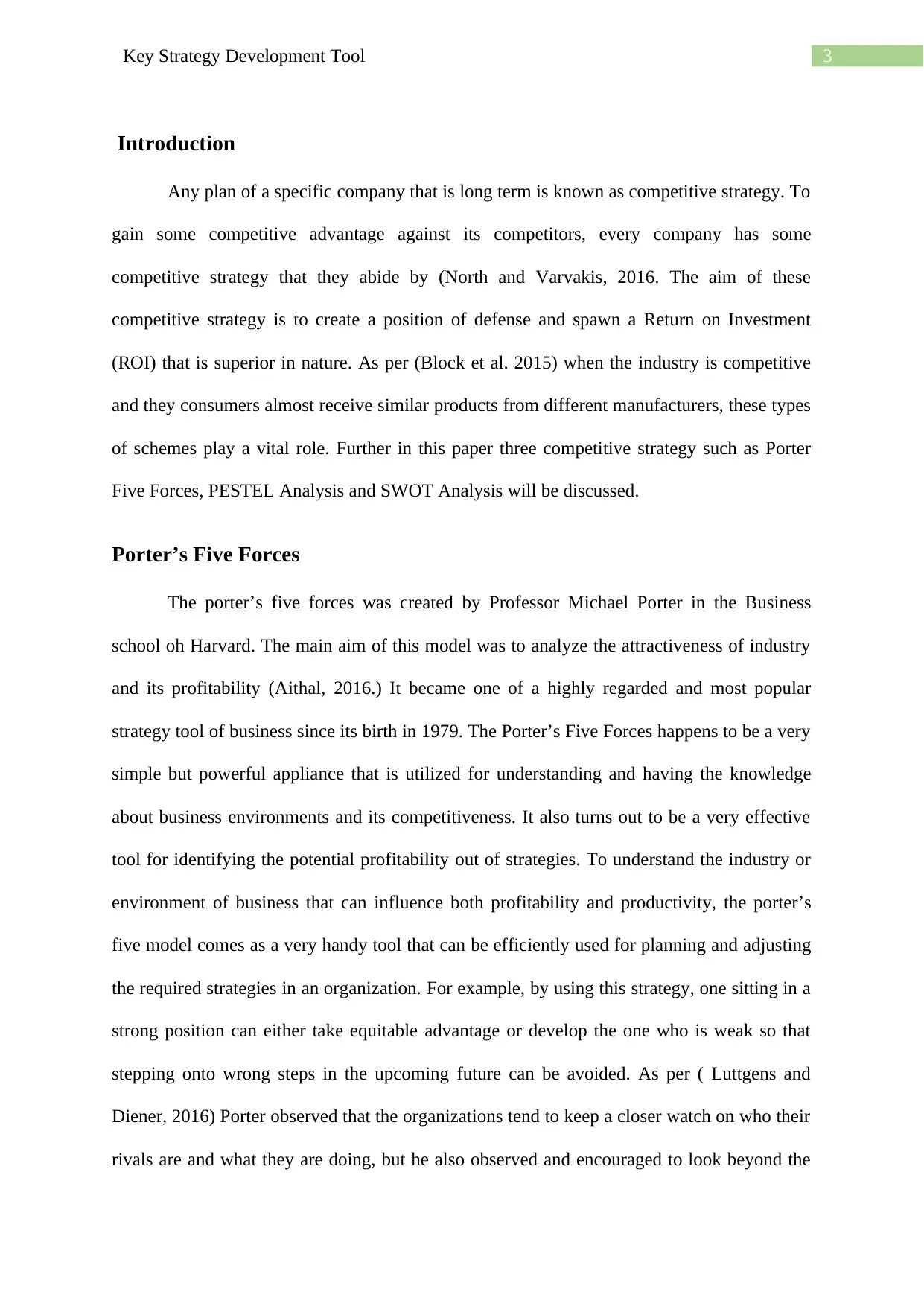
3Key Strategy Development Tool
Introduction
Any plan of a specific company that is long term is known as competitive strategy. To
gain some competitive advantage against its competitors, every company has some
competitive strategy that they abide by (North and Varvakis, 2016. The aim of these
competitive strategy is to create a position of defense and spawn a Return on Investment
(ROI) that is superior in nature. As per (Block et al. 2015) when the industry is competitive
and they consumers almost receive similar products from different manufacturers, these types
of schemes play a vital role. Further in this paper three competitive strategy such as Porter
Five Forces, PESTEL Analysis and SWOT Analysis will be discussed.
Porter’s Five Forces
The porter’s five forces was created by Professor Michael Porter in the Business
school oh Harvard. The main aim of this model was to analyze the attractiveness of industry
and its profitability (Aithal, 2016.) It became one of a highly regarded and most popular
strategy tool of business since its birth in 1979. The Porter’s Five Forces happens to be a very
simple but powerful appliance that is utilized for understanding and having the knowledge
about business environments and its competitiveness. It also turns out to be a very effective
tool for identifying the potential profitability out of strategies. To understand the industry or
environment of business that can influence both profitability and productivity, the porter’s
five model comes as a very handy tool that can be efficiently used for planning and adjusting
the required strategies in an organization. For example, by using this strategy, one sitting in a
strong position can either take equitable advantage or develop the one who is weak so that
stepping onto wrong steps in the upcoming future can be avoided. As per ( Luttgens and
Diener, 2016) Porter observed that the organizations tend to keep a closer watch on who their
rivals are and what they are doing, but he also observed and encouraged to look beyond the
Introduction
Any plan of a specific company that is long term is known as competitive strategy. To
gain some competitive advantage against its competitors, every company has some
competitive strategy that they abide by (North and Varvakis, 2016. The aim of these
competitive strategy is to create a position of defense and spawn a Return on Investment
(ROI) that is superior in nature. As per (Block et al. 2015) when the industry is competitive
and they consumers almost receive similar products from different manufacturers, these types
of schemes play a vital role. Further in this paper three competitive strategy such as Porter
Five Forces, PESTEL Analysis and SWOT Analysis will be discussed.
Porter’s Five Forces
The porter’s five forces was created by Professor Michael Porter in the Business
school oh Harvard. The main aim of this model was to analyze the attractiveness of industry
and its profitability (Aithal, 2016.) It became one of a highly regarded and most popular
strategy tool of business since its birth in 1979. The Porter’s Five Forces happens to be a very
simple but powerful appliance that is utilized for understanding and having the knowledge
about business environments and its competitiveness. It also turns out to be a very effective
tool for identifying the potential profitability out of strategies. To understand the industry or
environment of business that can influence both profitability and productivity, the porter’s
five model comes as a very handy tool that can be efficiently used for planning and adjusting
the required strategies in an organization. For example, by using this strategy, one sitting in a
strong position can either take equitable advantage or develop the one who is weak so that
stepping onto wrong steps in the upcoming future can be avoided. As per ( Luttgens and
Diener, 2016) Porter observed that the organizations tend to keep a closer watch on who their
rivals are and what they are doing, but he also observed and encouraged to look beyond the
Paraphrase This Document
Need a fresh take? Get an instant paraphrase of this document with our AI Paraphraser
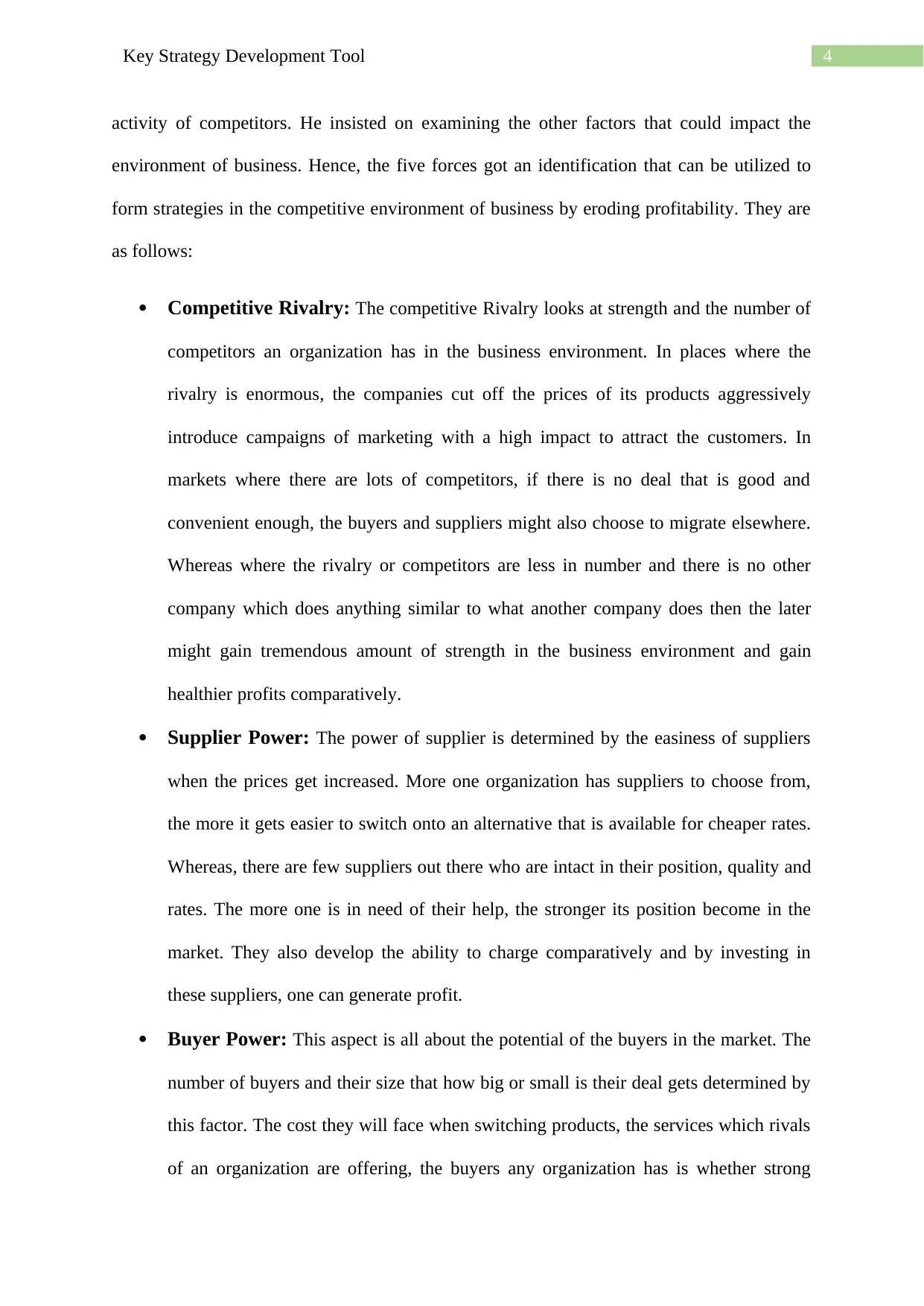
4Key Strategy Development Tool
activity of competitors. He insisted on examining the other factors that could impact the
environment of business. Hence, the five forces got an identification that can be utilized to
form strategies in the competitive environment of business by eroding profitability. They are
as follows:
Competitive Rivalry: The competitive Rivalry looks at strength and the number of
competitors an organization has in the business environment. In places where the
rivalry is enormous, the companies cut off the prices of its products aggressively
introduce campaigns of marketing with a high impact to attract the customers. In
markets where there are lots of competitors, if there is no deal that is good and
convenient enough, the buyers and suppliers might also choose to migrate elsewhere.
Whereas where the rivalry or competitors are less in number and there is no other
company which does anything similar to what another company does then the later
might gain tremendous amount of strength in the business environment and gain
healthier profits comparatively.
Supplier Power: The power of supplier is determined by the easiness of suppliers
when the prices get increased. More one organization has suppliers to choose from,
the more it gets easier to switch onto an alternative that is available for cheaper rates.
Whereas, there are few suppliers out there who are intact in their position, quality and
rates. The more one is in need of their help, the stronger its position become in the
market. They also develop the ability to charge comparatively and by investing in
these suppliers, one can generate profit.
Buyer Power: This aspect is all about the potential of the buyers in the market. The
number of buyers and their size that how big or small is their deal gets determined by
this factor. The cost they will face when switching products, the services which rivals
of an organization are offering, the buyers any organization has is whether strong
activity of competitors. He insisted on examining the other factors that could impact the
environment of business. Hence, the five forces got an identification that can be utilized to
form strategies in the competitive environment of business by eroding profitability. They are
as follows:
Competitive Rivalry: The competitive Rivalry looks at strength and the number of
competitors an organization has in the business environment. In places where the
rivalry is enormous, the companies cut off the prices of its products aggressively
introduce campaigns of marketing with a high impact to attract the customers. In
markets where there are lots of competitors, if there is no deal that is good and
convenient enough, the buyers and suppliers might also choose to migrate elsewhere.
Whereas where the rivalry or competitors are less in number and there is no other
company which does anything similar to what another company does then the later
might gain tremendous amount of strength in the business environment and gain
healthier profits comparatively.
Supplier Power: The power of supplier is determined by the easiness of suppliers
when the prices get increased. More one organization has suppliers to choose from,
the more it gets easier to switch onto an alternative that is available for cheaper rates.
Whereas, there are few suppliers out there who are intact in their position, quality and
rates. The more one is in need of their help, the stronger its position become in the
market. They also develop the ability to charge comparatively and by investing in
these suppliers, one can generate profit.
Buyer Power: This aspect is all about the potential of the buyers in the market. The
number of buyers and their size that how big or small is their deal gets determined by
this factor. The cost they will face when switching products, the services which rivals
of an organization are offering, the buyers any organization has is whether strong
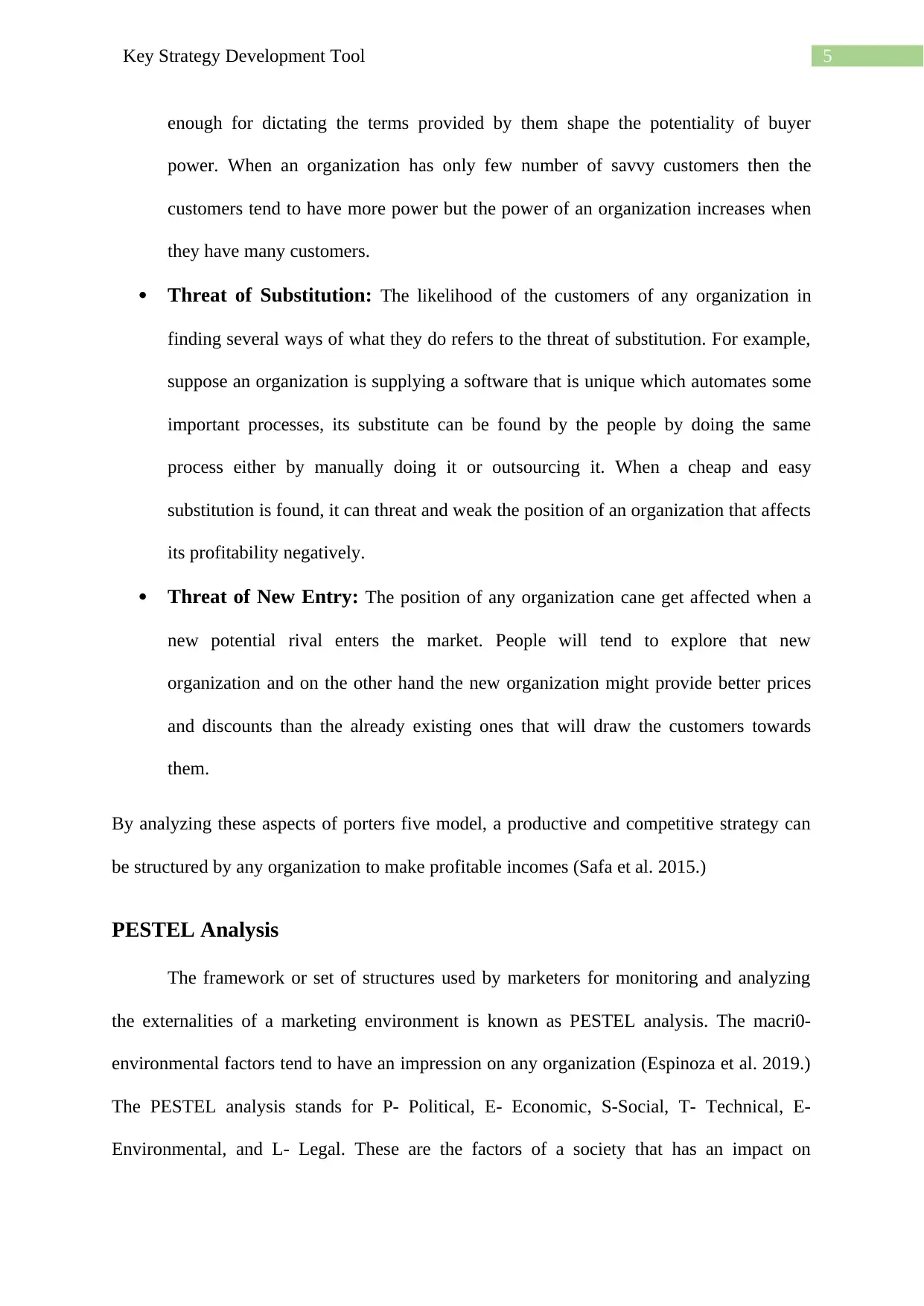
5Key Strategy Development Tool
enough for dictating the terms provided by them shape the potentiality of buyer
power. When an organization has only few number of savvy customers then the
customers tend to have more power but the power of an organization increases when
they have many customers.
Threat of Substitution: The likelihood of the customers of any organization in
finding several ways of what they do refers to the threat of substitution. For example,
suppose an organization is supplying a software that is unique which automates some
important processes, its substitute can be found by the people by doing the same
process either by manually doing it or outsourcing it. When a cheap and easy
substitution is found, it can threat and weak the position of an organization that affects
its profitability negatively.
Threat of New Entry: The position of any organization cane get affected when a
new potential rival enters the market. People will tend to explore that new
organization and on the other hand the new organization might provide better prices
and discounts than the already existing ones that will draw the customers towards
them.
By analyzing these aspects of porters five model, a productive and competitive strategy can
be structured by any organization to make profitable incomes (Safa et al. 2015.)
PESTEL Analysis
The framework or set of structures used by marketers for monitoring and analyzing
the externalities of a marketing environment is known as PESTEL analysis. The macri0-
environmental factors tend to have an impression on any organization (Espinoza et al. 2019.)
The PESTEL analysis stands for P- Political, E- Economic, S-Social, T- Technical, E-
Environmental, and L- Legal. These are the factors of a society that has an impact on
enough for dictating the terms provided by them shape the potentiality of buyer
power. When an organization has only few number of savvy customers then the
customers tend to have more power but the power of an organization increases when
they have many customers.
Threat of Substitution: The likelihood of the customers of any organization in
finding several ways of what they do refers to the threat of substitution. For example,
suppose an organization is supplying a software that is unique which automates some
important processes, its substitute can be found by the people by doing the same
process either by manually doing it or outsourcing it. When a cheap and easy
substitution is found, it can threat and weak the position of an organization that affects
its profitability negatively.
Threat of New Entry: The position of any organization cane get affected when a
new potential rival enters the market. People will tend to explore that new
organization and on the other hand the new organization might provide better prices
and discounts than the already existing ones that will draw the customers towards
them.
By analyzing these aspects of porters five model, a productive and competitive strategy can
be structured by any organization to make profitable incomes (Safa et al. 2015.)
PESTEL Analysis
The framework or set of structures used by marketers for monitoring and analyzing
the externalities of a marketing environment is known as PESTEL analysis. The macri0-
environmental factors tend to have an impression on any organization (Espinoza et al. 2019.)
The PESTEL analysis stands for P- Political, E- Economic, S-Social, T- Technical, E-
Environmental, and L- Legal. These are the factors of a society that has an impact on
⊘ This is a preview!⊘
Do you want full access?
Subscribe today to unlock all pages.

Trusted by 1+ million students worldwide
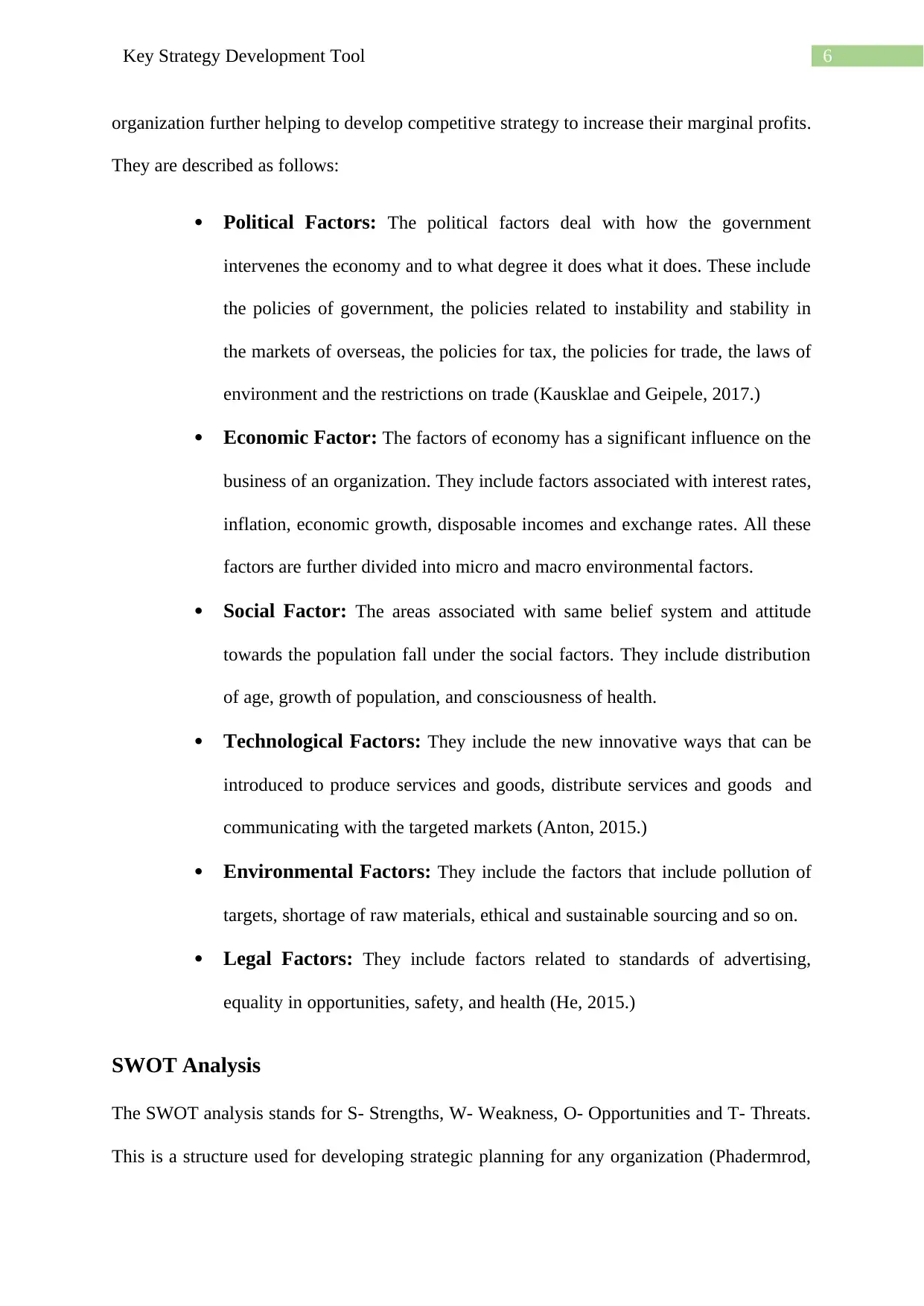
6Key Strategy Development Tool
organization further helping to develop competitive strategy to increase their marginal profits.
They are described as follows:
Political Factors: The political factors deal with how the government
intervenes the economy and to what degree it does what it does. These include
the policies of government, the policies related to instability and stability in
the markets of overseas, the policies for tax, the policies for trade, the laws of
environment and the restrictions on trade (Kausklae and Geipele, 2017.)
Economic Factor: The factors of economy has a significant influence on the
business of an organization. They include factors associated with interest rates,
inflation, economic growth, disposable incomes and exchange rates. All these
factors are further divided into micro and macro environmental factors.
Social Factor: The areas associated with same belief system and attitude
towards the population fall under the social factors. They include distribution
of age, growth of population, and consciousness of health.
Technological Factors: They include the new innovative ways that can be
introduced to produce services and goods, distribute services and goods and
communicating with the targeted markets (Anton, 2015.)
Environmental Factors: They include the factors that include pollution of
targets, shortage of raw materials, ethical and sustainable sourcing and so on.
Legal Factors: They include factors related to standards of advertising,
equality in opportunities, safety, and health (He, 2015.)
SWOT Analysis
The SWOT analysis stands for S- Strengths, W- Weakness, O- Opportunities and T- Threats.
This is a structure used for developing strategic planning for any organization (Phadermrod,
organization further helping to develop competitive strategy to increase their marginal profits.
They are described as follows:
Political Factors: The political factors deal with how the government
intervenes the economy and to what degree it does what it does. These include
the policies of government, the policies related to instability and stability in
the markets of overseas, the policies for tax, the policies for trade, the laws of
environment and the restrictions on trade (Kausklae and Geipele, 2017.)
Economic Factor: The factors of economy has a significant influence on the
business of an organization. They include factors associated with interest rates,
inflation, economic growth, disposable incomes and exchange rates. All these
factors are further divided into micro and macro environmental factors.
Social Factor: The areas associated with same belief system and attitude
towards the population fall under the social factors. They include distribution
of age, growth of population, and consciousness of health.
Technological Factors: They include the new innovative ways that can be
introduced to produce services and goods, distribute services and goods and
communicating with the targeted markets (Anton, 2015.)
Environmental Factors: They include the factors that include pollution of
targets, shortage of raw materials, ethical and sustainable sourcing and so on.
Legal Factors: They include factors related to standards of advertising,
equality in opportunities, safety, and health (He, 2015.)
SWOT Analysis
The SWOT analysis stands for S- Strengths, W- Weakness, O- Opportunities and T- Threats.
This is a structure used for developing strategic planning for any organization (Phadermrod,
Paraphrase This Document
Need a fresh take? Get an instant paraphrase of this document with our AI Paraphraser
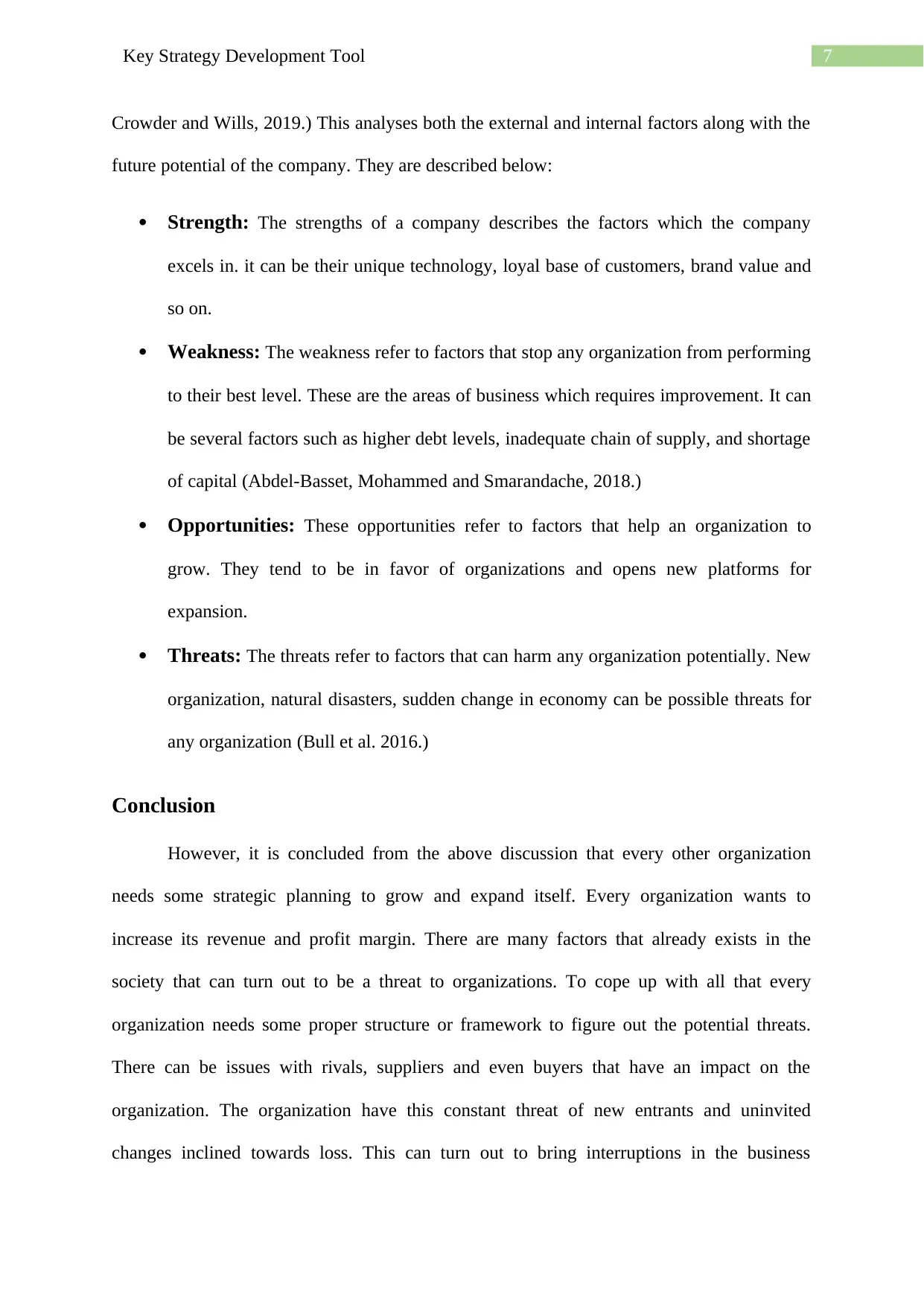
7Key Strategy Development Tool
Crowder and Wills, 2019.) This analyses both the external and internal factors along with the
future potential of the company. They are described below:
Strength: The strengths of a company describes the factors which the company
excels in. it can be their unique technology, loyal base of customers, brand value and
so on.
Weakness: The weakness refer to factors that stop any organization from performing
to their best level. These are the areas of business which requires improvement. It can
be several factors such as higher debt levels, inadequate chain of supply, and shortage
of capital (Abdel-Basset, Mohammed and Smarandache, 2018.)
Opportunities: These opportunities refer to factors that help an organization to
grow. They tend to be in favor of organizations and opens new platforms for
expansion.
Threats: The threats refer to factors that can harm any organization potentially. New
organization, natural disasters, sudden change in economy can be possible threats for
any organization (Bull et al. 2016.)
Conclusion
However, it is concluded from the above discussion that every other organization
needs some strategic planning to grow and expand itself. Every organization wants to
increase its revenue and profit margin. There are many factors that already exists in the
society that can turn out to be a threat to organizations. To cope up with all that every
organization needs some proper structure or framework to figure out the potential threats.
There can be issues with rivals, suppliers and even buyers that have an impact on the
organization. The organization have this constant threat of new entrants and uninvited
changes inclined towards loss. This can turn out to bring interruptions in the business
Crowder and Wills, 2019.) This analyses both the external and internal factors along with the
future potential of the company. They are described below:
Strength: The strengths of a company describes the factors which the company
excels in. it can be their unique technology, loyal base of customers, brand value and
so on.
Weakness: The weakness refer to factors that stop any organization from performing
to their best level. These are the areas of business which requires improvement. It can
be several factors such as higher debt levels, inadequate chain of supply, and shortage
of capital (Abdel-Basset, Mohammed and Smarandache, 2018.)
Opportunities: These opportunities refer to factors that help an organization to
grow. They tend to be in favor of organizations and opens new platforms for
expansion.
Threats: The threats refer to factors that can harm any organization potentially. New
organization, natural disasters, sudden change in economy can be possible threats for
any organization (Bull et al. 2016.)
Conclusion
However, it is concluded from the above discussion that every other organization
needs some strategic planning to grow and expand itself. Every organization wants to
increase its revenue and profit margin. There are many factors that already exists in the
society that can turn out to be a threat to organizations. To cope up with all that every
organization needs some proper structure or framework to figure out the potential threats.
There can be issues with rivals, suppliers and even buyers that have an impact on the
organization. The organization have this constant threat of new entrants and uninvited
changes inclined towards loss. This can turn out to bring interruptions in the business

8Key Strategy Development Tool
environment that is inevitable. They should be addressed in time and addressed with a proper
strategy. These are the times when tools like Porter’s Five Forces model, PESTEL analysis
and SWOT analysis comes to rescue and provide a proper framework.
References
Abdel-Basset, M., Mohamed, M. and Smarandache, F., 2018. An extension of neutrosophic
AHP–SWOT analysis for strategic planning and decision-making. Symmetry, 10(4),
p.116.
Aithal, P.S., 2016. Study on ABCD analysis technique for business models, business
strategies, operating concepts & business systems. International Journal in
Management and Social Science, 4(1).
Anton, R., 2015. An Integrated Strategy Framework (ISF) for Combining Porter's 5-Forces,
Diamond, PESTEL, and SWOT Analysis.
Block, J.H., Kohn, K., Miller, D. and Ullrich, K., 2015. Necessity entrepreneurship and
competitive strategy. Small Business Economics, 44(1), pp.37-54.
Bull, J.W., Jobstvogt, N., Böhnke-Henrichs, A., Mascarenhas, A., Sitas, N., Baulcomb, C.,
Lambini, C.K., Rawlins, M., Baral, H., Zähringer, J. and Carter-Silk, E., 2016.
Strengths, Weaknesses, Opportunities and Threats: A SWOT analysis of the
ecosystem services framework. Ecosystem services, 17, pp.99-111.
Espinoza, J.A., Proaño, P.A., Villavicencio, J.R. and Villegas, M.A., 2019. Extending
PESTEL technique to neutrosophic environment for decisions making in business
management. Neutrosophic Sets & Systems, 27.
environment that is inevitable. They should be addressed in time and addressed with a proper
strategy. These are the times when tools like Porter’s Five Forces model, PESTEL analysis
and SWOT analysis comes to rescue and provide a proper framework.
References
Abdel-Basset, M., Mohamed, M. and Smarandache, F., 2018. An extension of neutrosophic
AHP–SWOT analysis for strategic planning and decision-making. Symmetry, 10(4),
p.116.
Aithal, P.S., 2016. Study on ABCD analysis technique for business models, business
strategies, operating concepts & business systems. International Journal in
Management and Social Science, 4(1).
Anton, R., 2015. An Integrated Strategy Framework (ISF) for Combining Porter's 5-Forces,
Diamond, PESTEL, and SWOT Analysis.
Block, J.H., Kohn, K., Miller, D. and Ullrich, K., 2015. Necessity entrepreneurship and
competitive strategy. Small Business Economics, 44(1), pp.37-54.
Bull, J.W., Jobstvogt, N., Böhnke-Henrichs, A., Mascarenhas, A., Sitas, N., Baulcomb, C.,
Lambini, C.K., Rawlins, M., Baral, H., Zähringer, J. and Carter-Silk, E., 2016.
Strengths, Weaknesses, Opportunities and Threats: A SWOT analysis of the
ecosystem services framework. Ecosystem services, 17, pp.99-111.
Espinoza, J.A., Proaño, P.A., Villavicencio, J.R. and Villegas, M.A., 2019. Extending
PESTEL technique to neutrosophic environment for decisions making in business
management. Neutrosophic Sets & Systems, 27.
⊘ This is a preview!⊘
Do you want full access?
Subscribe today to unlock all pages.

Trusted by 1+ million students worldwide
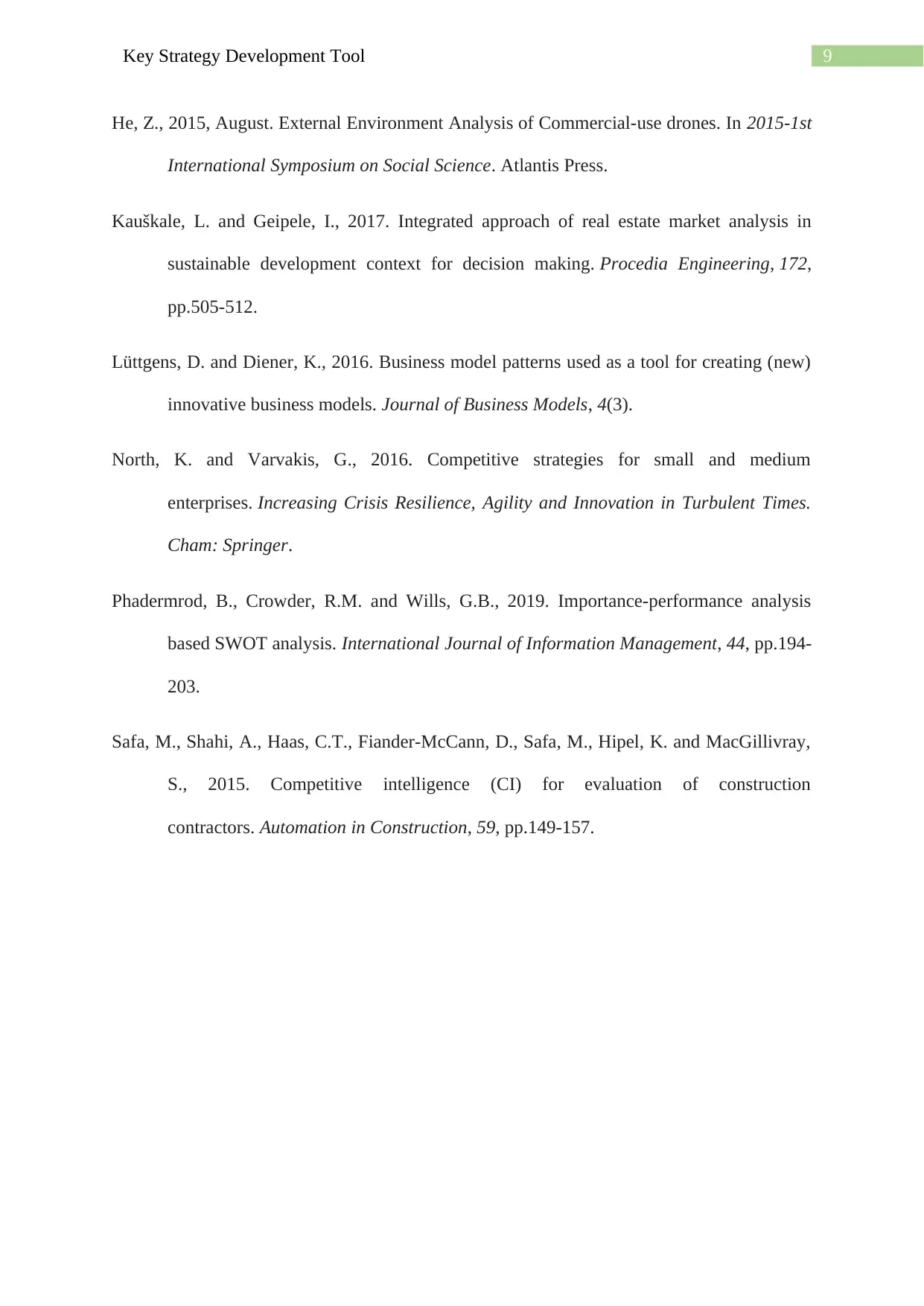
9Key Strategy Development Tool
He, Z., 2015, August. External Environment Analysis of Commercial-use drones. In 2015-1st
International Symposium on Social Science. Atlantis Press.
Kauškale, L. and Geipele, I., 2017. Integrated approach of real estate market analysis in
sustainable development context for decision making. Procedia Engineering, 172,
pp.505-512.
Lüttgens, D. and Diener, K., 2016. Business model patterns used as a tool for creating (new)
innovative business models. Journal of Business Models, 4(3).
North, K. and Varvakis, G., 2016. Competitive strategies for small and medium
enterprises. Increasing Crisis Resilience, Agility and Innovation in Turbulent Times.
Cham: Springer.
Phadermrod, B., Crowder, R.M. and Wills, G.B., 2019. Importance-performance analysis
based SWOT analysis. International Journal of Information Management, 44, pp.194-
203.
Safa, M., Shahi, A., Haas, C.T., Fiander-McCann, D., Safa, M., Hipel, K. and MacGillivray,
S., 2015. Competitive intelligence (CI) for evaluation of construction
contractors. Automation in Construction, 59, pp.149-157.
He, Z., 2015, August. External Environment Analysis of Commercial-use drones. In 2015-1st
International Symposium on Social Science. Atlantis Press.
Kauškale, L. and Geipele, I., 2017. Integrated approach of real estate market analysis in
sustainable development context for decision making. Procedia Engineering, 172,
pp.505-512.
Lüttgens, D. and Diener, K., 2016. Business model patterns used as a tool for creating (new)
innovative business models. Journal of Business Models, 4(3).
North, K. and Varvakis, G., 2016. Competitive strategies for small and medium
enterprises. Increasing Crisis Resilience, Agility and Innovation in Turbulent Times.
Cham: Springer.
Phadermrod, B., Crowder, R.M. and Wills, G.B., 2019. Importance-performance analysis
based SWOT analysis. International Journal of Information Management, 44, pp.194-
203.
Safa, M., Shahi, A., Haas, C.T., Fiander-McCann, D., Safa, M., Hipel, K. and MacGillivray,
S., 2015. Competitive intelligence (CI) for evaluation of construction
contractors. Automation in Construction, 59, pp.149-157.
1 out of 10
Related Documents
Your All-in-One AI-Powered Toolkit for Academic Success.
+13062052269
info@desklib.com
Available 24*7 on WhatsApp / Email
![[object Object]](/_next/static/media/star-bottom.7253800d.svg)
Unlock your academic potential
Copyright © 2020–2025 A2Z Services. All Rights Reserved. Developed and managed by ZUCOL.





